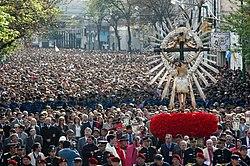Holy Week procession
This article includes a list of references, related reading or external links, but its sources remain unclear because it lacks inline citations. (December 2016) |
A Holy Week procession is a public ritual march of clergy and penitents which takes place during Holy Week in Christian countries, especially those with a Catholic culture. Various images of the saints, especially the Virgin Mary, and most importantly the image of the crucified Christ are carried aloft by foot as a penance; acts of mortification are carried out; traditional Christian hymns and chants are sung (except during the silent processions of Good Friday). In many confraternities of penitents, the faces of the members are covered by elaborate hoods, such as the capirote, as a way of hiding one's identity in order to not ostentatiously draw attention to oneself while performing penance. Crosses, and biers holding Catholic holy images surrounded with flowers and offerings of candles, are carried usually from one parish church to another led by the clergy, monastic orders, or heads of the penitential orders.





- Palm Sunday: The day when Jesus arrived in Jerusalem.
- Holy Thursday: The day when Jesus shared the Last Supper with His Apostles, followed by the beginning of his Passion.
- Good Friday: Jesus' crucifixion, performed in 14 stations.
- Holy Saturday: Loneliness of the Blessed Virgin Mary and the day that Jesus Christ's body lay in the tomb.
- Easter Sunday: The resurrection of the Christ.
Places famous for their Holy Week processions include:

- Colombia
- Corsica
- Calvi
- Sartène (See Catenacciu )
See also Holy Week processions in Guatemala
- Antigua Guatemala
- Guatemala City
- Honduras
- Comayagua
- Tegucigalpa
- Italy
- Taranto
- Chieti
- Trapani
 Holy Week Procession in Trapani (Italy)
Holy Week Procession in Trapani (Italy)
- Malta
- Mexico
- Iztapalapa
- Morelia
- Oaxaca City
- San Luis Potosí City
- Taxco
- Peru
- Arequipa
- Ayacucho
- Cusco
- Huaraz
- Tarma
- Philippines
- Baliuag
- Lipa City
- Makati
- Paete
- Pasig
- San Pablo, Laguna
- Porac, Pampanga
- Sta. Rita, Pampanga
- Sasmuan, Pampanga
- Vigan
- Portugal
- Holy Week in Braga, Braga
- Spain
- Andalusia
- Granada, declared of international tourism interest [1]
- Málaga, declared of international tourism interest
- Seville, declared of international tourism interest
- Castile and León
- León, declared of international tourism interest [2]
- Salamanca, declared of international tourism interest
- Valladolid, declared of international tourism interest
- Zamora, declared of international tourism interest
- Castile-La Mancha
- Hellin, declared of international tourism interest
- Toledo
- Region of Murcia
- Murcia, declared of national tourism interest, the typical with Francisco Salzillo images.
- Cartagena, declared of international tourism interest
- Lorca, declared of international tourism interest
- Other regions
- Ferrol, declared of international tourism interest in 2014 [3]
- Andalusia
Renowned sculptors of Holy Week include:
- Pedro Berruguete[citation needed]
- Gil de Siloé
- Juan de Juni
- Francisco Salzillo
- Juan de Mesa
- Gregorio Fernández
See also[]
References[]
External links[]
| Wikimedia Commons has media related to Taranto. |
- Qromi Malta
- Semana Santa – University of Guadalajara, Mexico (in Spanish)
- Holy Week in Málaga
- Holy Week in Taranto – Italy (in English - Spanish)
- Salzillo Processions in Murcia.
- Semana Santa Andina – Peru (in Spanish)
- Semana Santa in Popayán
- Semana Santa in Tunia, a small town near Popayan[permanent dead link]
- Holy Week in Lower Aragon
- Video Holy Week Procession El Encuentro in Alcañiz
- Holy Week in Nicaragua
- Eyewitness description of Holy Week processions in Cartagena
- Holy Week Procession in Baliuag, Bulacan
- Holy Week processions




